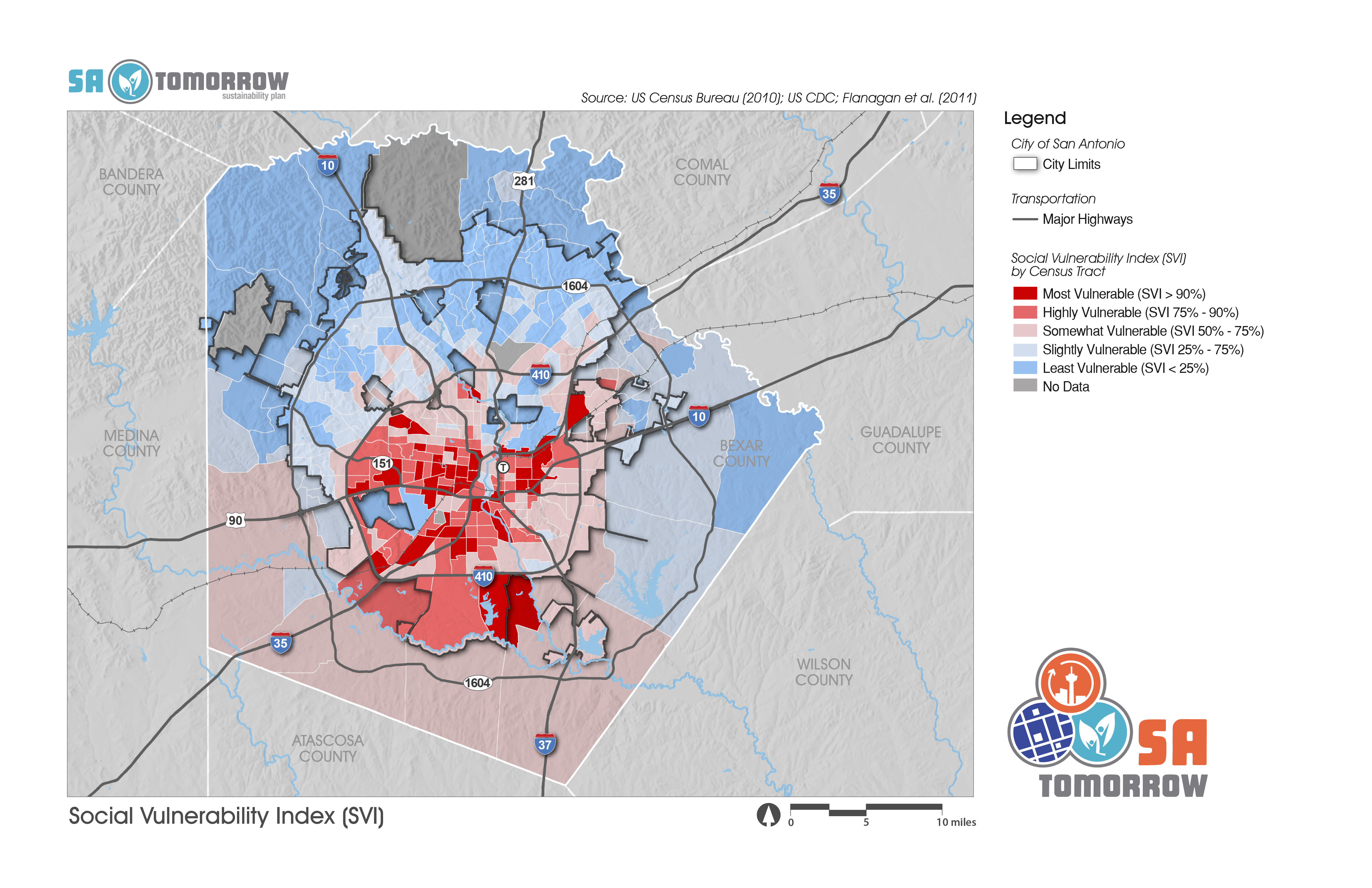What is Climate Equity?
What is Climate Equity?
Equity means that our policymaking, service delivery, and distribution of resources account for the different histories, challenges, and needs of the people we serve. A climate equity framework prioritizes resources and support to the communities burdened the most by climate change, those that contribute the least to climate change, and those who are most socially vulnerable to it. The City of San Antonio is committed to empowering these communities to overcome obstacles and achieve their own goals and ambitions. Furthermore, uplifting values of climate equity ensures that these communities play a central role in the just transformation of the systems that have established, and continue to perpetuate, the unequal burden of climate impacts.
There are direct connections between where our most marginalized community members live, the location of green spaces, and the urban heat island effect. These maps are used to prioritize action in areas where frontline communities are experiencing the worst effects of climate change.
The City of San Antonio Office of Equity collects and reports data to illuminate current racial disparities such as in education, housing, and health. The data is shared with City leadership and the greater public to strengthen the case for racial equity. Check out the 2019 Racial Equity Indicator Report.
The Social Vulnerability Index (SVI) helps identify communities that are most likely to need support before, during, and after a hazardous event or natural disaster, such as people who live in poverty, are chronically ill, disabled, over 65, or under 5 years old.
Climate Inequity and Health
Equitable and Accessible Engagement
Education & Empowerment is a foundational strategy for climate action, included in the SA Climate Ready Plan. The City is working with Texas Creative, Ltd. (TXC), a woman- and locally-owned public relations company, to ensure that the City of San Antonio communicates with the public in engaging and accessible ways. TXC has provided direct funding for local grassroots organizations, including disABILITYsa, The Empower House (formerly Martinez Street Women’s Center), Yanawana Herbolarios, and The Health Collaborative, to engage with frontline communities, and conduct a study to understand attitudes and perceptions of community members.
The study found that most San Antonio adults believe that climate change is occurring (81%) and having an impact on San Antonio (78%), and that government and business cooperation is needed to address climate change.Making Climate Equity a Reality in San Antonio
Planning for Equitable Action
Addressing major structural and institutional inequity, such as housing discrimination and neglected public infrastructure, will require the involvement of those affected by these issues in the policy planning process. San Antonians who are most vulnerable to climate impacts - communities of color, low-income communities, seniors, and people with disabilities - must have their voices heard to ensure that climate equity is at the forefront of the planning process.
Before implementing the actions and adaptation strategies in the City’s Climate Action and Adaptation Plan, each strategy will be evaluated by key community equity stakeholders using the Climate Equity Screening Tool. The tool is centered on five climate equity themes:
- Access and Accessibility
- Affordability
- Cultural Preservation
- Health
- Safety and Security
This tool will allow the City to identify potential burdens to vulnerable groups, reduce and eliminate these burdens, and find opportunities to improve quality of life for vulnerable groups. Those whose lives will be most impacted by climate change will influence decision-making around climate action and adaptation in our City.
Making Climate Equity a Reality in San Antonio
Equity Atlas
The City of San Antonio created a public, online Equity Atlas to help ensure that the City is making data-informed decisions which actively address disparities. Maps relating to basic demographic indicators such as race, income, and language are used to understand trends and gaps, with a goal of utilizing these maps in making more equitable policy decisions. As a result, the Atlas can help government and community partners make San Antonio a more inclusive and equitable city to live, learn, work, and play.
Making Climate Equity a Reality in San Antonio
Youth Engagement for Climate Initiatives
The second cohort of the Mayor’s Youth Engagement Council for Climate Initiatives (MYECCI), managed by EcoRise and funded by the Holloman Price Foundation, launched in Fall 2021 and consists of students representing 10 school districts with at least two students from each of the City’s Council Districts. MYECCI is one initiative of the Office of Sustainability’s climate education and empowerment program. Students will participate in citywide climate engagement and education campaigns to incorporate youth concerns and have the opportunity to engage with City Council members.
The second cohort of the MYECCI consists of 37 San Antonio high schoolers.
Making Climate Equity a Reality in San Antonio
What has the MYECCI Been Up To?
The MYECCI had its first successful cohort in the 2020-2021 school year. The cohort worked on projects and policy recommendations on the following topics: Infrastructure and Energy; Biodiversity; Community Health and Food Security; and Transportation and Housing. Examples of resulting projects including enhancing a bus stop with greenery and shade, installing a bug hotel, and starting a community garden. Six students who participated in the first MYECCI cohort were selected for paid summer internships generously funded by the Hollomon Price Foundation. The interns worked in the Office of Sustainability, Office of Historic Preservation, World Heritage Office, and partner organizations including the Texas Butterfly Ranch, and the San Antonio River Foundation. The MYECCI program was recognized with Honorable Mention in the Large City category as part of the 2021 Mayors Climate Protection Awards hosted by the US Conference of Mayors.









